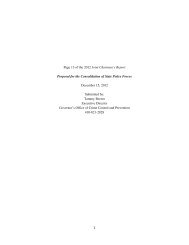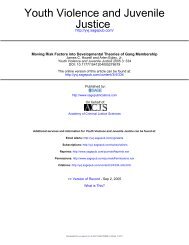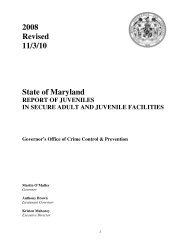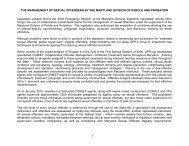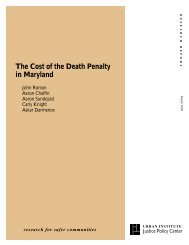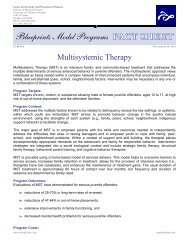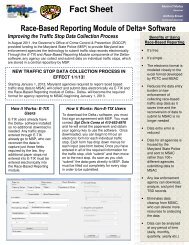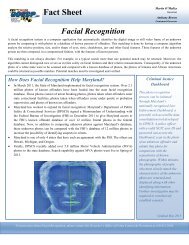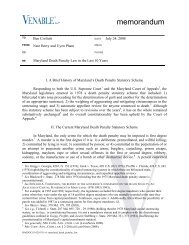Targeted Outreach - Governor's Office of Crime Control & Prevention ...
Targeted Outreach - Governor's Office of Crime Control & Prevention ...
Targeted Outreach - Governor's Office of Crime Control & Prevention ...
Create successful ePaper yourself
Turn your PDF publications into a flip-book with our unique Google optimized e-Paper software.
Appendices 67<br />
Appendix D<br />
Analytic Strategies<br />
• Y2 = a + b1Y1 + b2X + b3T + b4P + e1<br />
where: Y2 = the follow-up (12-month) value <strong>of</strong> the<br />
variable <strong>of</strong> interest<br />
Estimation <strong>of</strong> the effect <strong>of</strong> participation in GPTTO and<br />
GITTO relied heavily on multi-variate analysis. In general,<br />
the multi variate model used to estimate the effect <strong>of</strong><br />
GPTTO and GITTO on various outcome measures took<br />
the following form:<br />
• Y2 = a + b1Y1 + b2X + b3T + b4C + b4P + e1<br />
Y1<br />
X<br />
T<br />
= the baseline value <strong>of</strong> the variable <strong>of</strong><br />
interest<br />
= a vector <strong>of</strong> explanatory variables<br />
= whether the youth received<br />
GPTTO or GITTO treatment<br />
where: Y2 = the follow-up (12-month) value <strong>of</strong> the<br />
variable <strong>of</strong> interest<br />
Y1<br />
X<br />
T<br />
C<br />
P<br />
= the baseline value <strong>of</strong> the variable <strong>of</strong><br />
interest<br />
= a vector <strong>of</strong> explanatory variables<br />
= whether the youth received<br />
GPTTO or GITTO treatment<br />
= whether the youth came to BGC<br />
without being part <strong>of</strong> the<br />
GPTTO or GITTO target group<br />
= the level <strong>of</strong> participation at BGC<br />
a, bi = coefficients<br />
ei<br />
= a stochastic disturbance term wit a<br />
mean <strong>of</strong> zero and a constant variance<br />
The explanatory variable (X) included in the model were<br />
measures <strong>of</strong>: age, gender and race/ethnicity; gang risk factor<br />
score; level <strong>of</strong> social support received from adults and<br />
engagement in other after-school type activities; number <strong>of</strong><br />
stressful life events in the preceding year. For the intervention,<br />
we included a control for Club site; we were not able<br />
to include this control variable for prevention Clubs due<br />
to the large number <strong>of</strong> Clubs.<br />
This specification made it possible to estimate the effect <strong>of</strong><br />
GPTTO and GITTO more precisely by controlling for preexisting<br />
differences among youth. The estimated effect <strong>of</strong><br />
GPTTO and GITTO is the coefficient on the dichotomous<br />
variable T, b3.<br />
P<br />
= the level <strong>of</strong> participation at BGC<br />
a, bi = coefficients<br />
ei<br />
= a stochastic disturbance term wit a<br />
mean <strong>of</strong> zero and a constant variance<br />
The estimated effect <strong>of</strong> participation at the BGC is the<br />
variable P, b4.<br />
In addition to estimating the overall effect <strong>of</strong> the program<br />
using equation (1), a series <strong>of</strong> subgroup-treatment interaction<br />
variables were used to estimate the effect <strong>of</strong><br />
GPTTO/GITTO on gender and age subgroups.<br />
Algebraically, equation (1) was modified as follows:<br />
• Y2= a + b1Y1 + b2X + b3T + b4P + c1PM + e2<br />
• Y2= a + b1Y1 + b2X + b3T + b4P + c1PA1 + C2PA2 + e2<br />
where:<br />
M = a dummy variable that equals 1 for males<br />
Ai = Age category dummy variables for age<br />
13 to 15 and age 16 to 18<br />
(These are the variables only for prevention,<br />
with an omitted category <strong>of</strong> 9-12. For intervention,<br />
the variable is 14-18 with an omitted category<br />
<strong>of</strong> 9-13.)<br />
Ci = coefficients<br />
The use <strong>of</strong> ordinary least squares (OLS) was not warranted<br />
when the dependent variable was dichotomous, such as in<br />
the case <strong>of</strong> whether a participant initiated drug or alcohol<br />
use or initiated gang behaviors. In such cases, logistic<br />
regression analysis, using maximum likelihood estimation,<br />
was used to estimate the treatment impact by specifying a<br />
linear function for the logit (the logarithm <strong>of</strong> the odds) <strong>of</strong><br />
having a positive response (e.g., initiating drug use):



